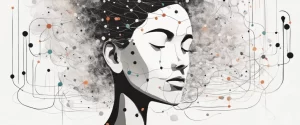
In an ever-evolving world where mental health issues are increasingly discussed, books that shed light on the human psyche and offer potential pathways to healing hold profound significance. Matt Haig’s “Reasons to Stay Alive” and Peter A. Levine’s “Waking the Tiger” are two such books that embark on a journey into the depths of human suffering, resilience, and the pursuit of a meaningful life.
Both books offer distinct perspectives on navigating the treacherous terrain of mental and emotional distress. “Reasons to Stay Alive” aims to capture the author’s struggle with depression, while “Waking the Tiger” delves into the realm of trauma and its profound impact on the individual. Through their unique insights, Haig and Levine provide readers with a plethora of knowledge, coping mechanisms, and words of hope in their quest for inner peace.
However varied their domains may be, both authors relentlessly explore the human experience and endeavor to unravel the complexities that lie at the core of our existence. Haig’s personal narrative in “Reasons to Stay Alive” draws readers into a chronicle of his own battles with depression, offering raw vulnerability and an intimate glimpse into the everyday fight against this mental illness. On the other hand, Levine’s “Waking the Tiger” ventures into the study of trauma, unveiling the long-lasting effects trauma can exert on the mind and body, while presenting a transformative approach to healing.
As we delve into the comparative study of these two groundbreaking works, we will explore the underlying themes, methodologies, and rhetorical strategies employed by Haig and Levine. We will analyze how each author sheds light on the exhaustion and hopelessness that can accompany mental health struggles, while providing valuable insights into the individuals’ resilience and capacity to heal.
Through the exploration of “Reasons to Stay Alive” and “Waking the Tiger,” readers will gain a profound understanding of the intricate nuances of mental health, trauma, and the human capacity for undying strength. These works affirm that, while individuals may feel isolated in their pain, they are not alone on their journey towards recovery and renewal.
In the following chapters, we will analyze these two crucial texts, highlighting the transformative power of candid self-reflection, grounded interdisciplinary research, and the fundamental need for empathy and compassion in the realm of mental and emotional well-being. Together, we embark on a collective quest to understand the delicate art of healing, as illuminated by the profound wisdom woven throughout “Reasons to Stay Alive” and “Waking the Tiger.”
Brief Summary of Two Books
Reasons to Stay Alive by Matt Haig
“Reasons to Stay Alive” is a memoir written by Matt Haig, describing his personal journey through depression and anxiety. The book serves as a candid and honest account of his experience with mental illness, providing insight into the debilitating effects it can have on individuals’ lives.
Haig delves into the darkest moments of his depression, sharing his thoughts of suicide and the overwhelming sense of despair that consumed him. However, he also explores the glimmers of hope and the small moments of joy that helped him to continue living.
Intertwined with his personal narrative, Haig presents essential insights into mental health, discussing the stigmas surrounding it and the various ways it can be treated. He explores his own recovery process, which involves therapy, medication, and lifestyle changes that aided his healing journey.
Moreover, tapping into his own experiences, Haig describes the profound impact that depression and anxiety can have on relationships and social interactions. He highlights the importance of empathy, understanding, and support from loved ones in helping individuals navigate their mental health struggles.
Ultimately, “Reasons to Stay Alive” is a hopeful and uplifting book that emphasizes the importance of resilience, self-acceptance, and seeking help in overcoming mental health challenges. Through his personal story, Haig offers solace and encouragement to those who may be experiencing similar struggles, reminding them that there are reasons to stay alive even in the darkest of times.
Waking the Tiger by Peter A. Levine
“Waking the Tiger: Healing Trauma” by Peter A. Levine is a groundbreaking book that explores the impact of trauma on the mind and body and offers a holistic approach to healing and recovery. Levine, a renowned psychologist and trauma expert, presents a revolutionary understanding of trauma by drawing inspiration from the animal kingdom.
The book emphasizes the role of the nervous system in trauma and highlights how animals naturally discharge and recover from traumatic experiences without lasting psychological or physiological effects. Levine argues that humans can learn from these instincts and employ them in their healing process. He introduces the concept of “felt sense,” a heightened body awareness, and encourages readers to listen to their bodies and connect with their instincts to release trapped trauma energy.
Levine also introduces the concept of “somatic experiencing,” a therapeutic approach that focuses on bodily sensations and the release of stored trauma. He explains how certain exercises and techniques can help individuals reclaim their bodies, regulate their nervous systems, and overcome the debilitating effects of trauma.
Throughout the book, Levine shares powerful case studies and personal anecdotes to illustrate the principles and practices he advocates. He explores various types of trauma, including childhood abuse, accidents, and war experiences, and sheds light on how trauma can be stored in the body, impacting physical health and emotional well-being.
Ultimately, “Waking the Tiger” offers a transformative perspective on trauma and provides practical tools for individuals seeking healing and recovery. Levine’s teachings empower readers to tap into their innate resiliency and reclaim their lives from the lasting effects of trauma.
Comparison between Two Books

Similarities in Mental Health
Reasons to Stay Alive by Matt Haig and Waking the Tiger by Peter A. Levine both explore the topic of mental health, although from different perspectives. They share several similarities in their approach to understanding and addressing mental health challenges:
1. Personal Experience: Both authors draw from their personal experiences with mental health issues. Matt Haig writes about his battle with depression and anxiety in Reasons to Stay Alive, while Peter A. Levine combines his professional expertise with his personal journey in Waking the Tiger.
2. Stigma and Shame: Both books acknowledge the existence of stigma and shame surrounding mental health and strive to break down these barriers. They highlight the importance of open conversations, understanding, and discovering ways to overcome the associated shame and social judgment.
3. Holistic Perspective: Both authors emphasize the importance of taking a holistic approach to mental health. They discuss the intricate connections between mind, body, and spirit, and stress the significance of addressing all aspects of one’s well-being for a comprehensive healing process.
4. Healing Trauma: Both books acknowledge the impact of trauma on mental health. Matt Haig and Peter A. Levine discuss various types of trauma and the different ways it can manifest, offering insights on how to recognize, understand, and heal from traumatic experiences.
5. Self-Compassion and Acceptance: Both authors advocate for self-compassion and self-acceptance. They encourage readers to practice self-love, embracing their vulnerabilities, and fostering a compassionate mindset towards themselves. By promoting acceptance, they aim to help individuals cultivate resilience and improve their mental well-being.
6. Mindfulness and Grounding Techniques: Both books touch upon the power of mindfulness and grounding techniques in managing mental health challenges. They outline specific practices that can help individuals stay present and connected to the present moment, aiding in stress reduction and emotional regulation.
7. Hope and Recovery: Both authors offer messages of hope for individuals struggling with mental health issues. They emphasize that recovery is possible and share personal anecdotes and stories of resilience to inspire readers on their own healing journeys.
While they approach mental health from different angles and perspectives, both Reasons to Stay Alive and Waking the Tiger share similar goals of raising awareness, destigmatizing mental health issues, and offering practical guidance for overcoming challenges and finding healing.
Divergences in Mental Health
Reasons to Stay Alive by Matt Haig and Waking the Tiger by Peter A. Levine are both books that explore the topic of mental health but from different perspectives. While both books discuss various aspects of mental health, they diverge in their approach, focus, and target audience.
One notable difference between the two books is their personal versus academic approach. Reasons to Stay Alive is a deeply personal account of Matt Haig’s struggle with depression and anxiety. It delves into his personal experiences, thoughts, and emotions, allowing readers to connect with the author on a more intimate level. On the other hand, Waking the Tiger is written by Peter A. Levine, a renowned therapist and practitioner in the field of trauma. His book takes a more academic approach, drawing on years of research and clinical experience to provide a scientific understanding of trauma and its impact on mental health.
Another divergence lies in their focus. Reasons to Stay Alive primarily explores the author’s battle with depression and anxiety, offering a deeply introspective, first-person perspective on these conditions. Haig provides vivid descriptions of his struggles, while also offering insight into the ways he has found hope and reasons to keep living. In contrast, Waking the Tiger focuses on trauma and its connection to mental health. Levine delves into the effects of unresolved trauma on the body and mind, providing techniques and exercises to heal and overcome these traumatic experiences.
Furthermore, the intended audience for each book differs. Reasons to Stay Alive is written for a general audience, aiming to provide support, hope, and understanding to anyone who has experienced mental health challenges. It speaks to those struggling with depression and anxiety, as well as their loved ones, with a focus on personal growth and resilience. Waking the Tiger, however, is more directed towards mental health professionals, therapists, and individuals specifically interested in trauma therapy. It delves into the complexities of trauma and is geared towards providing professionals with a deeper understanding of trauma and its effects on mental health.
In summary, while both Reasons to Stay Alive and Waking the Tiger explore mental health, they diverge in their approach, focus, and intended audience. Reasons to Stay Alive is a personal account of one man’s battle with depression and anxiety, providing hope and inspiration for a general audience. Waking the Tiger, on the other hand, approaches the topic from a more academic perspective, focusing on trauma and its impact on mental health, specifically targeting mental health professionals.

Conclusion
Both books offer valuable insights and perspectives, but the choice ultimately depends on your personal preferences and interests. Here is a brief overview of each book to help you make an informed decision:
1. “Reasons to Stay Alive” by Matt Haig: This book is a memoir that delves into the author’s personal experience with depression and anxiety. Haig openly explores his struggles and journey towards recovery, offering hope and inspiration to readers facing similar challenges. It provides a heartfelt and relatable account of mental health issues and emphasizes the importance of finding reasons to keep living.
2. “Waking the Tiger” by Peter A. Levine: This book focuses on understanding and healing trauma through the lens of Somatic Experiencing, a therapeutic approach developed by the author. Levine explores how trauma impacts the body and mind, and shares techniques to release traumatic stress and restore the nervous system’s natural balance. It offers a unique perspective on trauma healing and may be particularly useful for individuals interested in somatic therapy.
Ultimately, you may want to consider your specific interests and needs. If you are personally struggling with mental health, “Reasons to Stay Alive” may resonate more with you. On the other hand, if you are interested in trauma healing and exploring alternative therapeutic approaches, “Waking the Tiger” may be a better fit.


